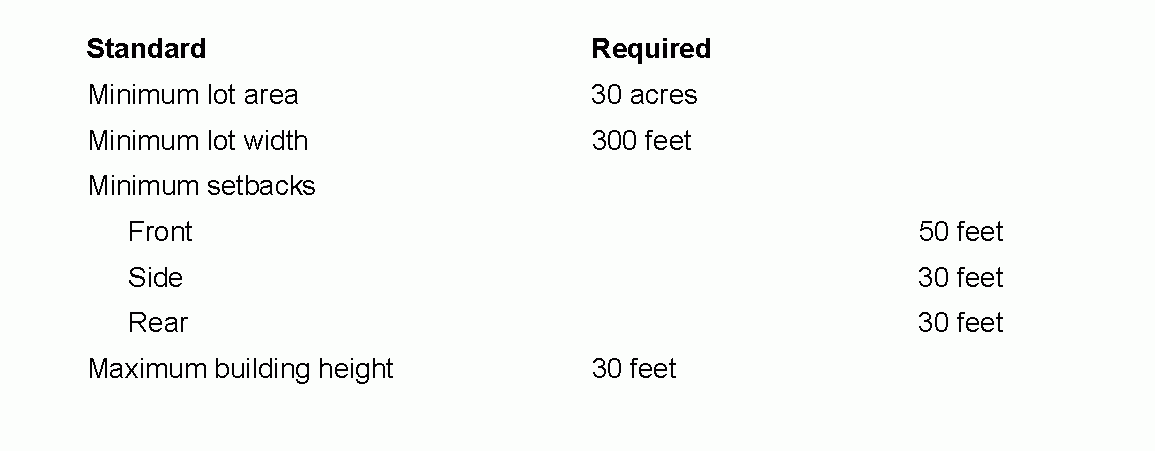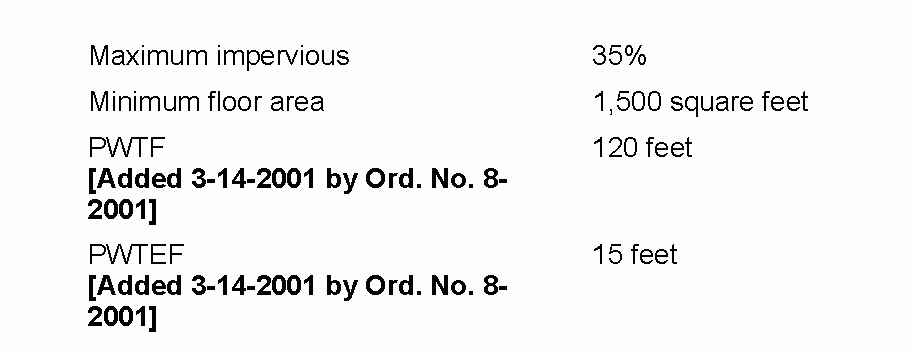A. Intent. The Planning Board has adopted a housing element and fair share plan element of the masterplan that recommends that the area in question be utilized for 100% affordable housing.�
B. Purpose. The purpose of the AHO-A is to establish an option to develop an industrial zoned area into a 100% affordable housing development when said uses can be adequately serviced by the sanitary sewer system.�
C. Zoning Created. There is created an AHO-A overlay zoning district. The following areas shall comprise the AHO-A overlay zoning district: Block 1029, Lots 1, 2, 3, 4, part of 5.01 and 34.�
D.Permitted principal uses shall be�
(1) 100% affordable multi-family attached housing developments�
E. Permitted accessory uses shall be�
(1) Public and private parking;�
(2) Clubhouse, playground or other recreational amenities normally associated with the principal residential use;�
(3) Rental and/or administrative offices accessory to the principal residential use; and�
(4) Other uses and structures customarily incidental to a principal permitted use.�
F. Area, yard and building requirements, as specified in §225-7�
G. Conditional uses�
(1) Public uses; and�
(2) Essential services.�
H. Other requirements shall be�
(1) All uses must be serviced by public water and public sanitary sewers;�
(2) Thirty percent (30%) of the gross lost area excluding storm water management basins must be for common open space; and�
(3)A buffer strip of 225 feet in width shall be required along all property lines. The buffer shall be in accordance with the requirements contained in Chapter 94-8.�
**Webmasters Note: § 225-40.1 has been added by Ordinance No. 23-2009, effective June 10, 2009.�
[Added 2-24-1993 by Ord. No. 9-1993; amended 7-14-1993 by Ord. No. 30-1993; 3-14-2001 by Ord. No. 8-2001; 6-12-2002 by Ord. No. 36-2002 8-14-2002 by Ord. No. 48-2002; 11-13-2002 by Ord. No. 72-2002]�
A. Permitted principal uses shall be:�
(1) Manufacturing of light machinery, such as small machine parts, typewriters, calculators and other office machines.�
(2) Fabrication of metal and wood products, such as baby carriages, bicycles, metal foil, metal furniture, musical instruments, sheet metal products and toys, boxes, cabinets and wood working and furniture.�
(3) Fabrication of paper products, such as bags, book binding, boxes and packaging materials, office supplies and toys.�
(4) The warehousing and storage of goods, including mini-warehouse and self-storage facilities.�
(5) Retail services, retail and wholesale sales.�
(6) Commercial recreation.�
(7) Hotels, motels and conference centers.�
(8) Education facilities, including commercial, private and public schools.�
(9) Branch banks, including drive-in banking facilities. [Amended 3-10-2004 by Ord. No. 11-2004]�
(10) Personal service establishments limited to shoe shops, laundries, barbershops, beauty parlors, hardware shops and drug stores.�
(11) Medical, professional and business offices.�
(12) Restaurants, including fast-food restaurants.�
**Webmasters Note: Subsection (12) has been amended by Ordinance No. 22-2011, effective June 22, 2011.�
(13) Convenience food stores, food markets, delicatessens and bakeries.�
(14) Auction houses.�
(15) Casino gaming equipment assembly, manufacturing, sales and service.�
(16) Mail, cargo and freight delivery and distribution facilities.�
(17) Research laboratories limited to electronics, pharmaceutical, experimental and testing�
(18) Other permissible manufacturing/fabrication, comprising any of the following: brush and broom manufacturing, electronic products, farm machinery, glass products, pharmaceutical products, photo finishing, pottery and ceramic products and thread and yarn manufacturing. In addition, any manufacturing/fabrication use not inconsistent with the specifically permitted uses are permitted, provided that the use does not produce any hazard from fire or explosion and does not result in any result in the dissemination of dust, smoke, smog, observable gas, fumes or odors or other atmospheric pollution, noise, glare, or vibration beyond the boundaries of the lot on which the creator of the condition is located.�
(19) Personal wireless telecommunications facility not to exceed 120 feet in height. [Added 5-14-2003 by Ord. No. 20-2003]�
B. Permitted accessory uses shall be:�
(1) Uses and buildings customary and incidental to the primary use or building.�
(2) Day care when established as an integral component of a principal use permitted in the district.�
(3) Cafeterias.�
(4) Private garages.�
(5) Personal wireless telecommunications equipment facility not to exceed 15 feet in height. [Added 5-14-2003 by Ord. No. 20-2003]�
C. Area, yard and building requirements shall be as specified in
(1) Industrial and office parks as specified in
(2) Gasoline filling stations subject to
(3) New auto sales and used auto sales and vehicle repair incidental thereto subject to
(4) Fast-food restaurants subject to
E. Other requirements shall be:�
(1) Landscape and buffer requirements as specified in 94-8 and 94-22 of the Township Code.�
(2) Transition or buffer area requirement. A landscaping buffer strip of 20 feet in width shall be installed along any common property line of a lot in the GC Zone and residential zones, except that when the adjoining lot in, the residential zone is used for nonresidential purposes, no buffer strip shall be required.�
[Added 11-13-1996 by Ord. No. 38-1996]�
A. Permitted uses. �
Principal uses permitted within the Auto Services Overlay District subject to site plan approval shall be:�
(1) Auto body and auto repair, including engine, brake and transmission repairs, which do not sell gasoline.�
(2) Wholesale and retail sales of automobiles and auto parts displayed out of doors in accordance with a site plan approved by the Planning Board.�
(3) Personal wireless telecommunications facility (PWTF) and personnel wireless telecommunications equipment facility (PWTEF). [Added 3-14-2001 by Ord. No. 8-2001]�
B. Bulk and area standards. �
The following bulk and area standards shall apply:�


C. Design and performance standards. �
The following design and performance standards shall apply:�
(1) All repair activities must be conducted within a fully enclosed building.�
(2) All lifts and other equipment must be located within a fully enclosed building.�
(3) Any motor vehicle awaiting repair may be located on the premises, provided that said vehicle is located in the rear or side yard and is screened from view such that no stored vehicle is visible from the front of the premises or from any adjacent premises.�
(4) No goods shall be displayed, stored or sold within 50 feet of a lot line or within required off-street parking or loading areas.�
(5) No goods shall be displayed in such a manner which will impede fire-fighting or other emergency equipment access to any structure.�
(6) A landscape strip or landscape buffer a minimum of 25 feet in width, designed in accordance with
(7) The site plan shall provide details and show the exact location of all existing and proposed structures, fences, signs, light standards, landscaping, parking spaces and the area to be utilized for the storage of motor vehicles.�
(8) Access driveways.�
(a) The minimum distance between any access driveways and a residence district or parcel used for residential purposes is 50 feet.�
(b) The minimum distance from adjoining property lines is 10 feet.�
(c) The minimum distance from minor intersections is 30 feet. Where intersecting streets are major or minor arterials as defined in the Master Plan, the minimum distance under this section shall be 50 feet. This distance shall be measured from the right-of-way lines of the intersecting streets involved.�
(d) The minimum distance between access driveways located on the subject premises shall be 30 feet.�
(e) No access shall be permitted through a residential area.�
(f) There shall be a maximum of two access points for ingress and egress on the subject premises.�
(9) Unless the property owner possesses a valid municipal junkyard license for the subject premises, wrecked or junked or stripped vehicles or vehicles in an inoperative condition shall not be permitted on the premises for a period of more than 30 days.�
[Added 2-24-1993 by Ord. No. 9-1993; amended 3-14-2001 by Ord. No. 8-2001; 6-12-2002 by Ord. No. 36-2002; 11-13-2002 by Ord. No. 72-2002]�
A. Permitted principal uses shall be:�
(1) Offices for business, professional and governmental purposes.�
(2) Administrative offices of commercial and industrial partnerships, companies or corporations, provided that the following requirements are met:�
(a) No sales of retail or wholesale nature shall be permitted on the premises.�
�
(b) No warehousing or storage of materials or equipment, including the storage of vehicles, other than the incidental storage of office supplies or records, shall be permitted on the premises.�
(3) Wholesaling, warehousing and distributing, excluding retail or wholesale sale of lumber, ice, coal, petroleum, quarried or mined material or similar bulk materials.�
(4) Branch banks, including drive-in banking facilities. [Amended 3-10-2004 by Ord. No. 11-2004]�
(5) Restaurants, not including fast-food restaurants.�
(6) Indoor athletic and recreational facilities.�
(7) Personal wireless telecommunications facility not to exceed 120 feet in height. [Added 5-14-2003 by Ord. No. 20-2003]�
B. Permitted accessory uses shall be:�
(1) Uses and buildings customary and incidental to the principal use or building.�
(2) Recreational facilities and cafeterias provided for employees when integrated into a planned office development incidental to the primary office use.�
(3) Security watch stations which may contain cooking and sleeping accommodations when integrated and incorporated into the primary building.�
(4) Repair facilities for the maintenance of vehicles used in the operation of a primary use.�
(5) Storage garages for vehicles used in the operation of the primary use.�
(6) Personal wireless telecommunications equipment facility not to exceed 15 feet in height. [Added 5-14-2003 by Ord. No. 20-2003]�
C. Area, yard and building requirements shall be as specified in
D. Permitted modifications and conditional uses shall be:�
(1) Office parks pursuant to the special requirements in
E. Site plan review. �
Site plan review shall be pursuant to Chapter 198 of the Code of the Township of Egg Harbor.�
F. Parking area requirements. �
�
Parking area requirements shall be pursuant to Article VII of this chapter.�
G. Buffer requirements. �
Buffer requirements shall be pursuant to Chapter 94 of the Code of the Township of Egg Harbor.�
H. Lighting requirements. �
Lighting requirements shall be pursuant to Chapter 94 of the Code of the Township of Egg Harbor.�
I. Landscaping requirements. �
Landscaping requirements shall be pursuant to Chapter 94 of the Code of the Township of Egg Harbor.�
J. Signs. �
Signs shall be regulated pursuant to Article VIII of this chapter.�